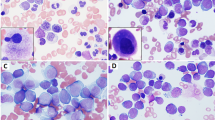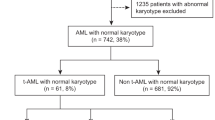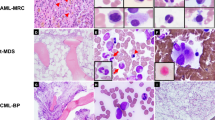Abstract
t(8;21)(q22;q22) is the most frequently observed karyotypic abnormality associated with acute myeloid leukemia (AML), especially in FAB M2. Clinically, this type of AML often shows eosinophilia and has a high complete remission rate with conventional chemotherapy. t(8;21) AML is also frequently associated with additional karyotypic aberrations, such as a loss of the sex chromosome; however, it is unclear whether these aberrations change the biological and clinical characteristics of t(8;21) AML. To investigate this issue, 94 patients with t(8;21) AML were categorized according to their additional karyotypic aberrations, which were detected in more than three cases, and then morphologic features, phenotypes, expression of cytokine receptors, and clinical features were compared to t(8;21) AML without other additional aberrant karyotypes. t(8;21) AML with loss of the sex chromosome and abnormality of chromosome 9 were found in 27 cases (29.3%) and 10 cases (10.6%), respectively; however, no differences were observed from the t(8;21) AML without other additional karyotypes in terms of morphological and phenotypic features. There was also no significant difference in the clinical outcome among these three groups. On the other hand, trisomy 4 was found in three cases (3.2%) and these cells showed low expressions of CD19 (P=0.06) and IL-7 receptor (P=0.05), and high expressions of CD33 (P=0.13), CD18 (P=0.03), and CD56 (P=0.03) when compared to t(8;21) AML without additional karyotypes. Moreover, all three t(8;21) AML cases with trisomy 4 did not show eosinophilia in their bone marrow and died within 2.4 years. These observations suggest that additional karyotypic aberration, t(8;21) with trisomy 4 is rare, but it may constitute a distinctive subtype of t(8;21) AML.
This is a preview of subscription content, access via your institution
Access options
Subscribe to this journal
Receive 12 print issues and online access
$259.00 per year
only $21.58 per issue
Buy this article
- Purchase on Springer Link
- Instant access to full article PDF
Prices may be subject to local taxes which are calculated during checkout





Similar content being viewed by others
References
Bennett JM, Catovsky D, Daniel MT, Flandrin G, Galton DA, Gralnick HR et al. Proposed revised criteria for the classification of acute myeloid leukemia: a report of the French–American–British Cooperative Group. Ann Intern Med 1985; 103: 620–625.
Bennett JM, Catovsky D, Daniel MT, Flandrin G, Galton DA, Gralnick HR et al. Proposal for the recognition of minimally differentiated acute myeloid leukaemia (AML-M0). Br J Haematol 1991; 78: 325–329.
Rowley JD . Recurring chromosome abnormalitoes in leukemia and lymphoma. Semin Hematol 1990; 27: 122–136.
Fenaux P, Preudhomme C, Laï JL, Morel P, Beuscart R, Bauters F . Cytogenetics and their prognostic value in de novo acute myeloid leukaemia: a report on 283 cases. Br J Haematol 1989; 73: 61–67.
Schiffer CA, Lee EJ, Tomiyasu T, Wiernik PH, Testa JR . Prognostic impact of cytogenetic abnormalities in patients with de novo acute nonlymphocytic leukemia. Blood 1989; 73: 263–270.
Dastugue N, Payen C, Lafage-Pochitaloff M, Bernard P, Leroux D, Huguet-Rigal F et al. Prognostic significance of karyotype in de novo adult acute myeloid leukemia. Leukemia 1995; 9: 1491–1498.
Bloomfield CD, Lawrence D, Byrd JC, Carroll A, Pettenati MJ, Tantravahi R et al. Frequency of prolonged remission duration after high-dose cytarabine intensification in acute myeloid leukemia varies by cytogenetic subtype. Cancer Res 1998; 58: 4173–4179.
Hurwitz CA, Raimondi SC, Head D, Krance R, Mirro Jr J, Kalwinsky DK et al. Distinctive immunophenotypic features of t(8;21)(q22;q22) acute myeloblastic leukemia in children. Blood 1992; 80: 3182–3188.
Kita K, Nakase K, Miwa H, Masuya M, Nishii K, Morita N et al. Phenotypical characteristics of acute myelocytic leukemia associated with the t(8;21)(q22;q22) chromosomal abnormality: frequent expression of immature B-cell antigen CD19 together with the stem cell antigen CD34. Blood 1992; 80: 470–477.
Kita K, Shirakawa S, Kamada N . Cellular characteristics of acute myeloblastic leukemia associated with t(8;21)(q22;q22). The Japanese Cooperative Group of Leukemia/Lymphoma. Leukemia Lymphoma 1994; 13: 2229–2234.
Nishii K, Kita K, Nadim M, Miwa H, Ohoish K, Yamaguchi M et al. Expression of interleukin-5 receptors on acute myeloid leukaemia cells: association with immunophenotype and karyotype. Br J Haematol 1995; 91: 169–172.
Andrieu V, Radford-Weiss I, Troussard X, Chane C, Valensi F, Guesnu M et al. Molecular detection of t(8;21)/AML1-ETO in AML M1/M2: correlation with cytogenetics, morphology and immunophenotype. Br J Haemotol 1996; 92: 855–865.
Shikami M, Miwa H, Nishii K, Takahashi T, Sekine T, Mahmud N et al. Low BCL-2 expression in acute leukemia with t(8;21) chromosomal abnormality. Leukemia 1999; 13: 358–368.
Raspadori D, Damiani D, Lenoci M, Rondelli D, Testoni N, Nardi G et al. CD56 antigenic expression in acute myeloid leukemia identifies patients with poor clinical prognosis. Leukemia 2001; 15: 1161–1164.
Lorsbach RB, McNall R, Mathew S . Marked bone marrow basophilia in a child with acute myeloid leukemia with a cryptic t(8;21)(q22;q22) chromosomal translocation. Leukemia 2001; 15: 1799–1801.
Groupe Francais de Cytogenetique Hematogique. Acute myelogenous leukemia with an 8;21 translocation. A report on 148 cases from the Groupe Francais de Cytogenetique Hematologique. Cancer Genet Cytogenet 1990; 44: 169–179.
Ohno R, Kobayashi T, Tanimoto M, Hiraoka A, Imai K, Asou N et al. Randomized study of indualized induction therapy with or without vincristine, and of maintenance-intensification therapy between 4 or 12 courses in adult acute myeloid leukemia. AML-87 study of the Japan Adult Leukemia Study Group. Cancer 1993; 71: 3888–3895.
Kobayashi T, Miyawaki S, Tanimoto M, Kuriyama K, Mueakami H, Yashida M et al. Randomized trials between behenoyl cytarabine and cytarabine in combination induction and consolidation therapy, and with or without ubenimex after maintenance/intensification therapy in adult acute myeloid leukemia. J Clin Oncol 1996; 14: 204–213.
Miyawaki S, Tanimoto M, Kobayashi T, Minami S, Tamura J, Omoto E et al. No beneficial effect from addition of etoposide to daunorubicin, cytarabine, and 6-mercaptopurine in individualized induction therapy of adult acute myeloid leukemia: the JALSG-AML92 study. Int J Hematol 1999; 70: 97–104.
Kageyama S . Toxicity and safety of JALSG-AML95 study for newly diagnosed adult acute myelogeneous leukemia. LALSG 10-year Anniversary International Symposium, 1997, pp 30–31.
Sakamaki H, Miyawaki S, Hatake K, Takahashi M, Minami S, Kobayashi T et al. JALSG AML-97 protocol. LALSG 10-year Anniversary International Symposium, 1997, pp 32–34.
Suzuki A, Kimura Y, Ohyashiki K, Kitano K, Kageyama S, Kasai M et al. Trisomy 10 in acute myeloid leukemia. Three additional cases from the database of the Japan Adult Leukemia Study Group (JALSG) AML-92 and AML-95. Cancer Genet Cytogenet 2000; 15: 141–143.
Nishii K, Katayama N, Miwa H, Shikami H, Masuya M, Shiku H et al. Survival of human leukaemic B-cell precursors is supported by stromal cells and cytokines: association with the expression of bcl-2 protein. Br J Haematol 1999; 105: 701–710.
Nishii K, Usui E, Sakakura M, Miyata E, Ride SA, Ford AM et al. Additional t(11;17)(q23;q21) in a patient with Philadelphia-positive mixed lineage antigen-expressing leukemia. Cancer Genet Cytogenet 2001; 126: 8–12.
Nishii K, Katayama N, Miwa H, Shikami M, Usui E, Masuya M et al. Non-DNA-binding Ikaros isoforms gene expressed in adult B-precursor acute lymphoblastic leukemia. Leukemia 2002; 16: 1285–1292.
Wattjes MP, Krauter J, Nagel S, Heidenreich O, Ganser A, Heil G . Comparison of nested competitive RT-PCR and real-time RT-PCR for the detection and quantification of AML1/MTG8 fusion transcripts in t(8;21) positive acute myelogous leukemia. Leukemia 2000; 14: 329–335.
Nucifora G, Dickstein JI, Torbenson V, Roulston D, Rowley JD, Vardiman JW . Correlation between cell morphology and expression of the AML1/ETO chimeric transcript in patients with acute myeloid leukemia without the t(8;21). Leukemia 1994; 8: 1533–1538.
Ferrara F, Del Vecchio L . Acute myeloid leukemia with t(8;21)/AML1/ETO: a distinct biological and clinical entity. Haematologica 2002; 87: 306–319.
Ema H, Kitano K, Suda T, Sato Y, Muroi K, Ohta M et al. In vitro differentiation of leukemic cells to eosinophils in the presence of interleukin-5 in two cases of acute myeloid leukemia with the translocation (8;21)(q22;q22). Blood 1990; 75: 350–356.
Tatsumi E, Yoneda N, Kawano S, Yamaguchi N, Yabe H, Nagai K et al. Expression of CD7 antigen precludes t(8;21)(q22;q22) chromosome aberration in acute myeloblastic leukemia. Blood 1992; 79: 3092–3093.
Miyoshi H, Kozu T, Shimizu K, Enomoto K, Maseki N, Kaneko Y et al. The t(8;21) translocation in acute myeloid leukemia results in production of an AML1-MTG8 fusion transcript. EMBO J 1993; 12: 2715–2721.
Shimada H, Ichikawa H, Ohki M . Potential involvement of the AML1-MTG8 fusion protein in the granulocytic maturation characteristic of the t(8;21) acute myelogenous leukemia revealed by microarray analysis. Leukemia 2002; 16: 874–885.
Kawano S, Miyanishi S, Shimizu K, Tanaka K, Okumura A, Ohki M et al. Genetic analysis of 8;21 chromosomal translocation without AML1 gene involvement in MDS-AML. Br J Haematol 1997; 99: 632–640.
Asou H, Tashiro S, Hamamoto K, Otsuji A, Kita K, Kamada N . Establishment of a human acute myeloid leukemia cell line (Kasumi-1) with 8;21 translocation. Blood 1991; 77: 2031–2036.
Mecucci C, Van Orshoven A, Tricot G, Michaux JL, Delannoy A, Van den Berghe H . Trisomy 4 identifies a subset of acute nonlymphocytic leukemias. Blood 1986; 67: 1328–1332.
Weber E, Nowoty H, Haas OA, Kasparu H, Grois N, Lutz D . Trisomy 4: a specific karyotype anomaly in primary and secondary acute myeloid leukemia. Leukemia 1990; 4: 219–221.
Wong KF, So CC . Acute myeloid leukemia with concominant trisomies 4 and 10: a distinctive form of myeloid leukemia? Cancer Genet Cytogenet 2001; 127: 74–76.
Keung Y, Kaplan B, Douer D . Biphenotypic M0 acute myeloid leukemia with trisomy-4. Leukemia Lymphoma 1994; 14: 181–184.
Baer MR, Stewart CC, Lawrence D, Arthur DC, Byrd JC, Davey FR et al. Expression of the neural cell adhesion molecule CD56 is associated with short remission duration and survival in acute myeloid leukemia with t(8;21)(q22;q22). Blood 1997; 90: 1643–1648.
Sandberg AA, Van den Berghe H, Hecht F . Trisomy 4 in hematologic disorders. Cancer Genet Cytogenet 1987; 26: 175.
Bonomi R, Le Coniat M, Berger R . Is trisomy 4 a secondary chromosomal abnormality in acute myeloblastic leukemia? Cancer Genet Cytogenet 1995; 79: 186–187.
Yamamoto K, Nagata K, Kida A, Hamaguchi H, Inagaki K . Karyotypic conversion from trisomy 4 to trisomy 14 during the evolution of therapy-related myelodysplastic syndrome to acute myeloblastic leukemia. Cancer Genet Cytogenet 2002; 132: 83–84.
Acknowledgements
Thanks are due to Drs SI Kageyama, M Masuya, K Ohishi, M Yamaguchi, H Mitani, H Araki, M Sakakura, Y Sugimoto (Second Department of Internal Medicine, Mie University School of Medicine, Mie, Japan); K Kawakami, Y Watanabe (Suzuka Gentral Hospital, Mie, Japan); K Oka (Suzuka Kaisei Hospital, Mie, Japan); T. Sekine (Matsusaka Genaral Hospital, Mie, Japan); K Tsuji, S Tamaki (Yamada Red Cross Hospital, Mie, Japan); T Tsukada, H Kihira (Takeuchi Hospital, Mie, Japan); K, Ikeda (Ise Citizen Hospital, Mie, Japan); M Shikami (The Second Department of Internal Medicine, Aich University School of Medicine, Aich, Japan); I Furuta, M Itou (Shinguu Citizen Hospital); M Nomura (Third Department of Internal Medicine, Kyoto Prefectural University of Medicine); and H Tsutani (First Department of Internal Medicine, Fukui Medical University, Fukui, Japan).
This work was supported by research grants from the Ministry of Education, Culture, Sports, Science, and Technology and from the Ministry of Health, Labour, and Welfare, Tokyo, Japan.
Author information
Authors and Affiliations
Rights and permissions
About this article
Cite this article
Nishii, K., Usui, E., Katayama, N. et al. Characteristics of t(8;21) acute myeloid leukemia (AML) with additional chromosomal abnormality: concomitant trisomy 4 may constitute a distinctive subtype of t(8;21) AML. Leukemia 17, 731–737 (2003). https://doi.org/10.1038/sj.leu.2402871
Published:
Issue Date:
DOI: https://doi.org/10.1038/sj.leu.2402871
Keywords
This article is cited by
-
Deep learning detects acute myeloid leukemia and predicts NPM1 mutation status from bone marrow smears
Leukemia (2022)
-
Chromosome integrity checkpoints in stem and progenitor cells: transitions upon differentiation, pathogenesis, and aging
Cellular and Molecular Life Sciences (2018)
-
Restoration of MYC-repressed targets mediates the negative effects of GM-CSF on RUNX1-ETO leukemogenicity
Leukemia (2017)
-
Centrosome amplification, chromosomal instability and cancer: mechanistic, clinical and therapeutic issues
Chromosome Research (2016)
-
Prognostic factors in acute promyelocytic leukemia: strategies to define high-risk patients
Annals of Hematology (2016)



